
Oda Nobunaga was a Japanese daimyō and one of the leading figures of the Sengoku period. He is regarded as the first "Great Unifier" of Japan.
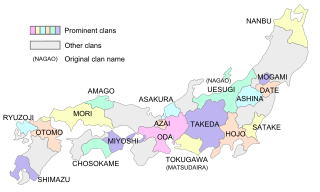
Daimyo were powerful Japanese feudal lords who, from the 10th century to the early Meiji period in the middle 19th century, ruled most of Japan from their vast, hereditary land holdings. They were subordinate to the shōgun and nominally to the emperor and the kuge. In the term, dai (大) means "large", and myō stands for myōden (名田), meaning "private land".
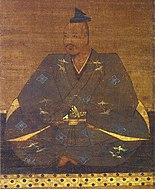
Takeda Shingen, of Kai Province, was a pre-eminent daimyō in feudal Japan with exceptional military prestige in the late stage of the Sengoku period.
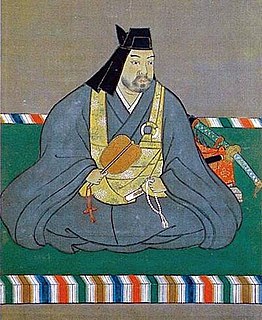
Uesugi Kenshin was a daimyō who was born as Nagao Kagetora, and after adoption into the Uesugi clan, ruled Echigo Province in the Sengoku period of Japan. He was one of the most powerful daimyōs of the Sengoku period. While chiefly remembered for his prowess on the battlefield, Kenshin is also regarded as an extremely skillful administrator who fostered the growth of local industries and trade; his rule saw a marked rise in the standard of living of Echigo.

Uesugi Kagekatsu was a Japanese samurai daimyō during the Sengoku and Edo periods.
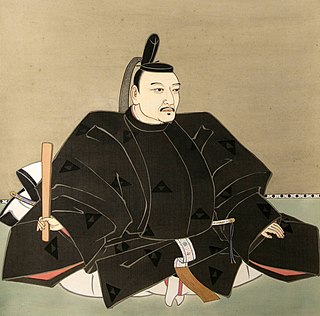
Hōjō Ujimasa was the fourth head of the later Hōjō clan, and daimyō of Odawara. His childhood name was Matsuchiyo-maru (松千代丸). He was a son-in-law of Takeda Shingen.

The Takeda Clan was a Japanese clan active from the late Heian period until the late 16th century. The clan was historically based in Kai Province in present-day Yamanashi Prefecture. The clan was known for their honorable actions under the rule of Takeda Shingen, one of the most famous rulers of the period.

The Uesugi clan was a Japanese samurai clan, descended from the Fujiwara clan and particularly notable for their power in the Muromachi and Sengoku periods.
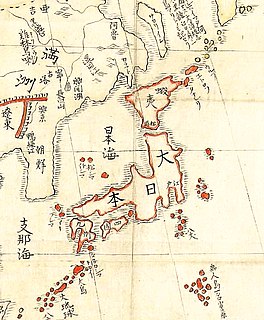
This is the glossary of Japanese history including the major terms, titles and events the casual reader might find useful in understanding articles on the subject.
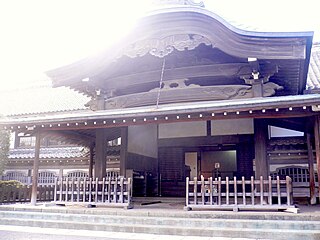
The 1545–1546 Siege of Kawagoe Castle was part of a failed attempt by the Uesugi clan to regain Kawagoe Castle from the Later Hōjō clan in the Sengoku period of Japan. Uesugi Tomosada of the Ogigayatsu branch of the Uesugi clan was joined by his more powerful relative Uesugi Norimasa, by Ashikaga Haruuji, the Kantō kubō in Koga, and by a host of anti-Hōjō daimyō from the Kantō region.

Hōjō Ujiyasu was a daimyō (warlord) and third head of the Odawara Hōjō clan. Known as the "Lion of Sagami", he was revered as a fearsome warrior and a cunning man. He is famous for his strategies that defeated Shingen and Kenshin. The son of Hōjō Ujitsuna, his only known wife was Imagawa Yoshimoto's sister, Zuikei-in. Among his sons are Hōjō Ujimasa and Uesugi Kagetora.
Uesugi Kagetora was the seventh son of Hōjō Ujiyasu; he was adopted by Uesugi Kenshin, and was meant to be Kenshin's heir. However, in 1578, he was attacked in his castle at Otate by Uesugi Kagekatsu—Kagetora's respective brother-in-law—and was subsequently defeated. Kagetora committed suicide the following year.
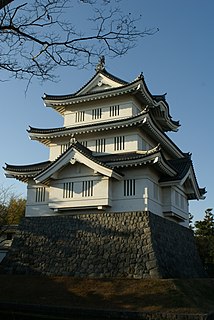
The 1590 Siege of Oshi was one of many battles in Toyotomi Hideyoshi's campaigns against the Hōjō clan during Japan's Sengoku period.
Nagao Tamekage was a retainer of Japanese feudal lord Uesugi Fusayoshi, and a daimyō in his own right, during Japan's Sengoku period.
Ashikaga Domain was a feudal domain under the Tokugawa shogunate of Edo period Japan, located in Shimotsuke Province, Japan. It was centered on Ashikaga jin'ya in what is now part of the city of Ashikaga. Ashikaga was ruled through most of its history by a junior branch of the Toda clan.
Sano Domain was a feudal domain under the Tokugawa shogunate of Edo period Japan, located in Shimotsuke Province, Japan. It was centered in what is now part of the city of Sano, Tochigi. Sano was ruled through most of its history by a junior branch of the Hotta clan.

Iwatsuki Castle is a Japanese castle located in Iwatsuki-ku, Saitama, in Saitama Prefecture, Japan. At the end of the Edo period, Tateyama Castle was home to the Ōoka clan, daimyō of Iwatsuki Domain, however the castle dates from the Muromachi period and was inhabited by many samurai lords over its history. During the Edo period, the name of the castle was written as “岩付城”. It was also known as "White Crane Castle" or "Floating Castle". The site of the castle is a Saitama Prefectural Historic Monument.
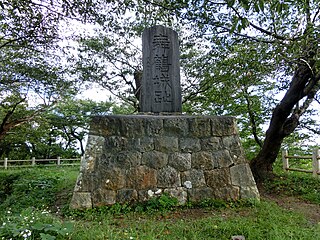
Murakami Castle is a Japanese castle located in Murakami, northern Niigata Prefecture, Japan. At the end of the Edo period, Murakami Castle was home to a cadet branch of the Naitō clan, daimyō of Murakami Domain under the Tokugawa shogunate. The castle was also known as "Maizuru-jō" (舞鶴城). It has been protected by the central government as a National Historic Site since 1993.

Sakado Castle was a Sengoku period yamajiro-style Japanese castle located in what is now the city of Minamiuonuma, Niigata Prefecture, in the Hokuriku region of Japan. It has been protected by the central government as a National Historic Site since 1979.

Lady Shirai was a Japanese noble lady and aristocrat from the Sengoku period. She was born to the Nagao clan in Shirai, who were head retainers to the Uesugi clan in Kantō. She was the wife of Narita Nagayasu, the lord of Oshi castle in Musashi. She is also thought to be either the daughter or granddaughter of Nagao Kageharu. Lady Shirai was a retainer of the Ashikaga Shogunate, fought and died during the Incident of Kyoto in 1565, when Ashikaga Yoshiteru was killed.















